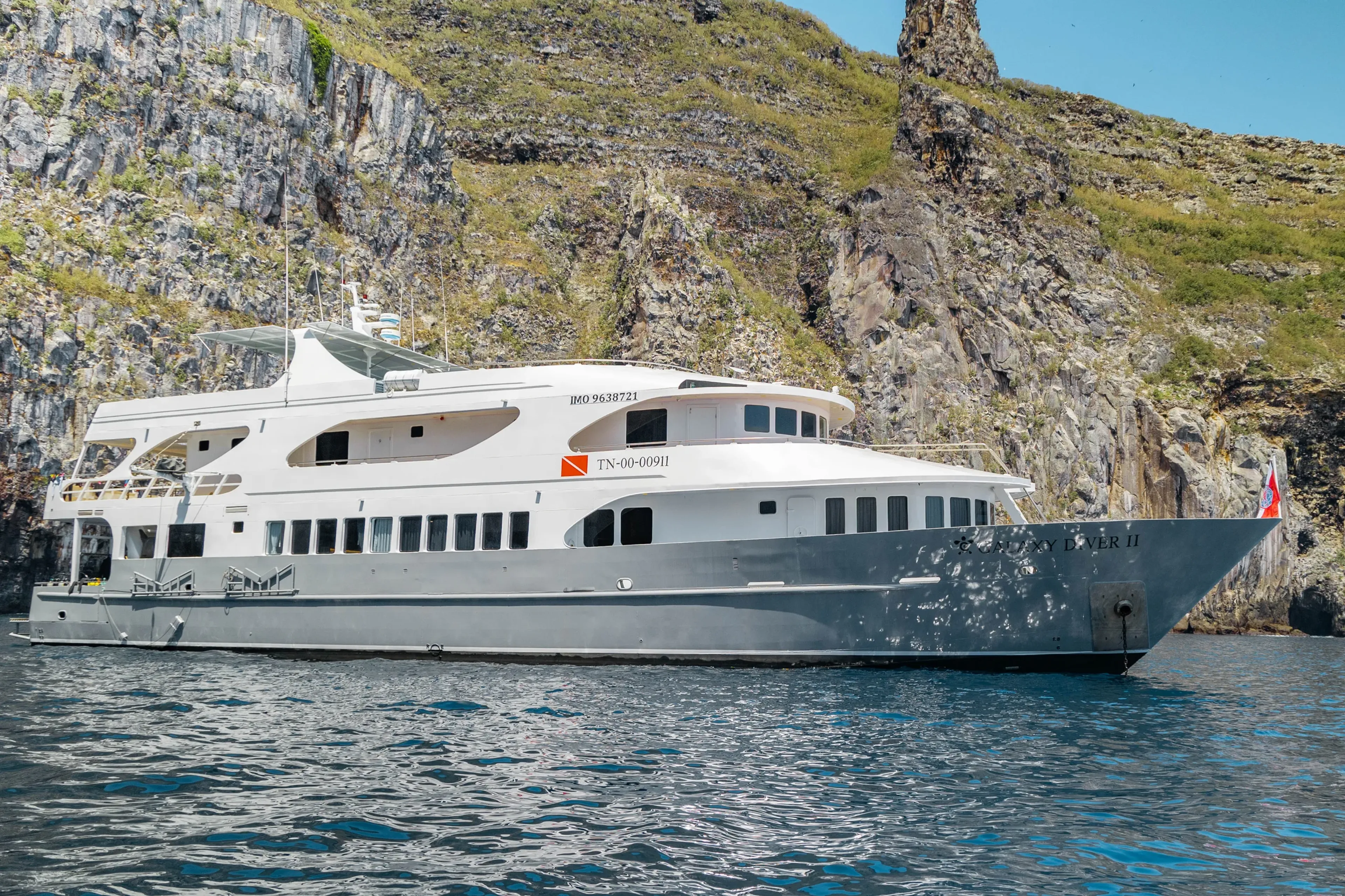Dive the Galápagos With This Locally-Owned Liveaboard!
Overall Rating
It is one of the best liveaboards I have done in my 25 years of diving. 8 unforgettable days on a boat with the best amenities, excellent crew and experienced guides. The equipment was provided in perfect condition and the food on board was phenomenal. They had options for all tastes. On these trips, divers share a common interest and it is the love of nature. This is a space to share our adventures and experiences. On this occasion, I was lucky enough to share with a group of unparalleled, fun, experienced divers and I will take with me the best memories of them and of the unique dives we did together and that Darwin, Wolf and the Galapagos in general offer. I would do this trip and on this boat again without a doubt.
Why We Love It
This liveaboard belongs to a company managed in the Galapagos for more than twenty years. The itinerary will take you to all the famous sites around five islands: Darwin and Wolf, Fernandina, Isabela, and Santiago islands. Get ready to see a lot of pelagic action: hammerhead sharks, Galápagos sharks, eagle and manta rays, the endemic marine iguanas, sea lions, leatherback turtles.. and many more!
Conservation
The mother company is from the Galapagos itself. They promote local employment, environmental conservation and responsible tourism. This liveaboard is using biofuel.
Who Is It For?
A minimum of 50 logged dives and an Advanced Open Water are required. The strong currents attract pelagic species, making most sites challenging.
Prices and Dates
Loading...
Dive Briefing!
Marine Life
- The Galápagos Marine Reserve, established in 1998, is the second-largest marine preserve in the world.
- The Marine Reserve has been a UNESCO World Heritage Site since 2001 (an expansion from the Galápagos National Park, which was recognized in 1978).
- Located at the confluence of three ocean currents, the Galápagos are a "melting pot" of marine species - the extraordinary diversity of marine life is unmatched anywhere else in the world.
- Nearly 20% of marine life in the Galápagos is endemic, found nowhere else on earth, such as the world’s only marine iguana and the most northerly-living penguin.
- Due to the island's topography, pelagic species such as tuna, manta ray, and hammerhead shark can be seen extremely close to the shoreline.
- The diversity of underwater terrain is exceptional and cannot be found anywhere else in the world.
Dive Conditions
- Season: December to May is when manta rays are more commonly sighted. It is the warmest season, but daily rain showers and cloudier skies should also be expected. June to November is when the Humboldt current comes up from the south, bringing with it plankton and making this the best time to see whale sharks. Cooler temperatures with occasional showers should be expected.
- Currents: medium to strong
- Visibility: 10 to 20 m (30 to 66 ft)
- Water Temperature: 23° to 29°C (73° to 84°F) from December to May and 22° to 27°C (72° to 81°F) between June and November, with some thermoclines.
- Depth: shallow and deep dives
Dive Sites
- The dive sites visited are Baltra North East, El Derrumbe, La Ventana, Shark Bay, La Banana, El Arenal, the Darwin's Towers, Cape Douglas, Vicente Roca Point, and Cousin Rock.
The Team
- Dive operator in the area since 2022. Naturalist tours since 2002.
- Boat renovated in 2022
- Languages spoken: English, Spanish
- Maximum 6 divers per guide until the end of May 2024 and then 8 divers per guide
Safety Information
- Equipment Recommended: a 7 mm long wetsuit, a hood, dive gloves, an SMB, a reef hook, and the usual diving equipment. All can be rented on board.
- Insurance: Both dive insurance and travel insurance are mandatory. We recommend DAN Europe, which has plans to cover both - ask us for a quote.
- Nearest Hyperbaric Chamber: Puerto Ayora on Santa Cruz Island
Visas, Flights, and More!
Visa Requirements
- You must have a valid passport to enter Ecuador, and a return ticket
- Most citizens do not require a visa to stay in Ecuador for up to 90 days
- Ensure your passport is valid for at least 6 months beyond the period you intend to stay
- Please check current visa policies that apply for your country on Ecuador Virtual Consulate
How to Get There
- You need to go to Guayaquil (GYE) or Quito first, at the Mariscal Sucre International Airport (UIO) in Ecuador.
- Plan to arrive in Ecuador at least one day before the cruise departure.
- The following day, take a domestic flight from Quito to Seymour Airport (GPS) in Baltra Island.
- In all cases, we recommend spending an additional night before the cruise in Santa Cruz Island in Galápagos to ensure you don't miss any connections and are well-rested before diving.
More...
- Bring reef-safe sunscreen, a hat, mosquito repellent, and long clothing (dengue is present in the Galápagos).
- December to May has an average daytime air temperature of 23° (73°F) with daily rain showers and cloudier skies.
- June to November is drier, but with cooler temperatures - an average of 21° (70°F) - with local rain showers generally confined to the highlands of the larger islands. Evening temperatures can drop to just 15° (59°F) , so bring extra trousers, jumpers, and a windbreaker.
Destinations
Right Season
Dive Operators
Booking Fees


